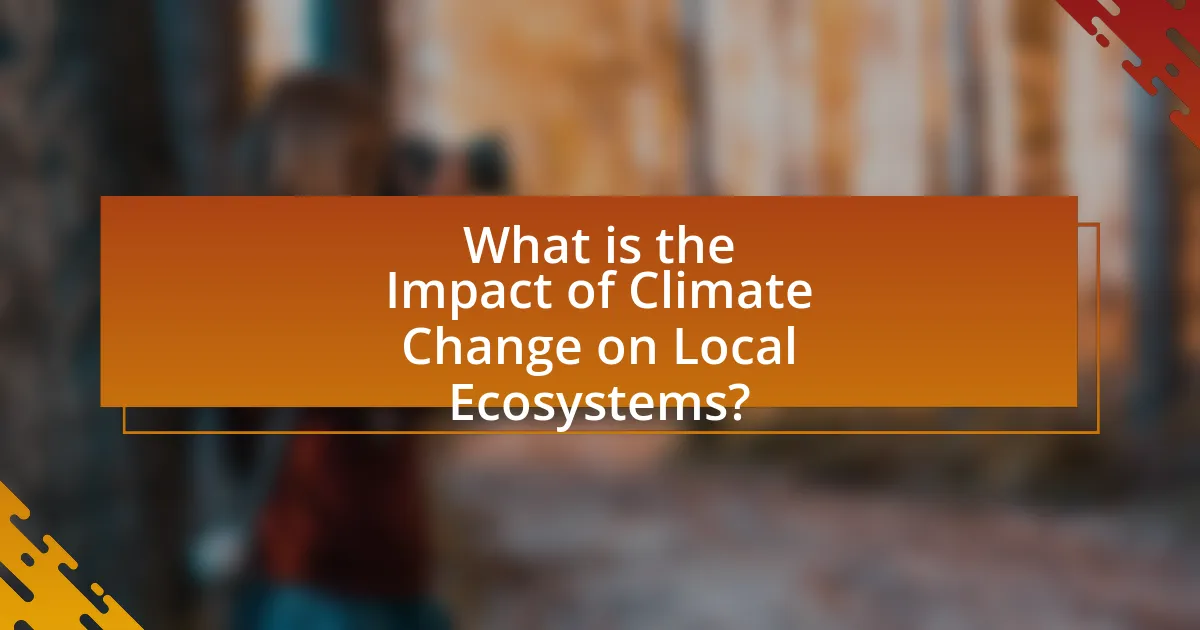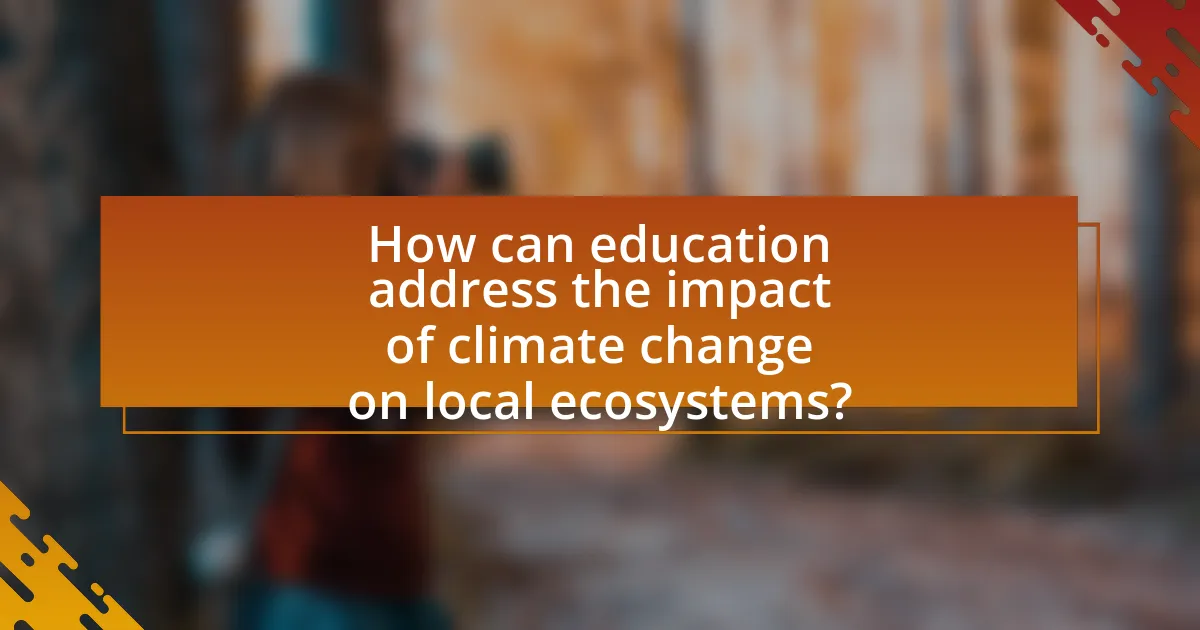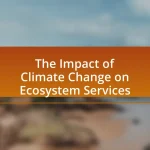The article focuses on the impact of climate change on local ecosystems and emphasizes the importance of education in addressing these challenges. It outlines how climate change disrupts species distributions, affects biodiversity, and alters ecosystem services, leading to significant risks for various species, including coral reefs and polar bears. The article also discusses the implications of changing temperature and precipitation patterns on flora and fauna, water quality, soil health, and human communities. Furthermore, it highlights the role of education in raising awareness and fostering community engagement to mitigate climate change effects, while providing practical steps individuals and communities can take to protect local ecosystems.

What is the Impact of Climate Change on Local Ecosystems?
Climate change significantly disrupts local ecosystems by altering species distributions, affecting food webs, and changing habitat conditions. For instance, rising temperatures can lead to shifts in plant and animal ranges, as species migrate to cooler areas, which can result in the loss of biodiversity. According to the Intergovernmental Panel on Climate Change (IPCC), approximately 1 million species are at risk of extinction due to climate-related changes. Additionally, altered precipitation patterns can lead to habitat degradation, impacting freshwater and terrestrial ecosystems. These changes can destabilize food chains, as seen in coral reefs where increased ocean temperatures cause bleaching, affecting marine biodiversity.
How does climate change affect biodiversity in local ecosystems?
Climate change negatively affects biodiversity in local ecosystems by altering habitats, disrupting species interactions, and increasing extinction rates. Rising temperatures and changing precipitation patterns lead to habitat loss and fragmentation, making it difficult for many species to survive. For instance, a study published in “Nature” by Thomas et al. (2004) found that approximately 1 million species are at risk of extinction due to climate change impacts. Additionally, shifts in climate can cause mismatches in timing between species, such as pollinators and flowering plants, further threatening local biodiversity.
What specific species are most vulnerable to climate change?
Coral reefs, polar bears, and certain amphibians are among the species most vulnerable to climate change. Coral reefs are highly sensitive to temperature changes and ocean acidification, with studies indicating that increased sea temperatures can lead to widespread bleaching events, threatening their survival. Polar bears rely on sea ice for hunting seals, and as climate change causes ice to melt, their habitat is severely diminished, leading to population declines. Additionally, amphibians, such as the golden toad, are particularly susceptible to changes in temperature and humidity, with many species experiencing significant declines due to habitat loss and disease exacerbated by climate change. These examples illustrate the direct impact of climate change on specific species, highlighting their vulnerability in changing ecosystems.
How do changes in temperature and precipitation impact local flora and fauna?
Changes in temperature and precipitation significantly affect local flora and fauna by altering their habitats and life cycles. For instance, increased temperatures can lead to shifts in plant blooming periods, which may disrupt the timing of pollinator activity, ultimately affecting food availability for herbivores and, consequently, predators. A study published in “Nature Climate Change” by Parmesan and Yohe (2003) found that many species are already experiencing changes in their distribution due to climate shifts, with some moving to higher altitudes or latitudes in search of suitable conditions. Additionally, altered precipitation patterns can lead to droughts or flooding, impacting water availability for plants and animals, which can result in reduced biodiversity and ecosystem resilience.
What are the observable effects of climate change on ecosystem services?
Climate change has observable effects on ecosystem services, including alterations in biodiversity, shifts in species distribution, and changes in the timing of biological events. These changes impact the provision of services such as pollination, water purification, and carbon sequestration. For instance, a study published in the journal “Nature” found that rising temperatures have led to earlier flowering times in plants, which disrupts the synchronization between pollinators and flowering plants, ultimately affecting food production and ecosystem stability. Additionally, the Intergovernmental Panel on Climate Change (IPCC) reports that climate change is causing habitat loss and degradation, which further threatens biodiversity and the resilience of ecosystems.
How does climate change influence water quality and availability?
Climate change significantly influences water quality and availability by altering precipitation patterns, increasing temperatures, and exacerbating extreme weather events. These changes lead to reduced freshwater availability due to increased evaporation and altered hydrological cycles, which can result in droughts in some regions and flooding in others. For instance, the National Oceanic and Atmospheric Administration (NOAA) reports that rising temperatures can lead to harmful algal blooms, which degrade water quality by producing toxins that affect aquatic life and human health. Additionally, increased rainfall intensity can cause runoff that carries pollutants into water bodies, further compromising water quality. Thus, climate change directly impacts both the quantity and quality of water resources available for ecosystems and human use.
What role does climate change play in soil health and productivity?
Climate change significantly impacts soil health and productivity by altering temperature and precipitation patterns, which can lead to soil degradation and reduced agricultural yields. Increased temperatures can accelerate organic matter decomposition, diminishing soil fertility, while altered rainfall patterns can cause erosion, nutrient leaching, and reduced water availability for crops. According to the Intergovernmental Panel on Climate Change (IPCC), these changes can lead to a decline in soil organic carbon levels, which are crucial for maintaining soil structure and fertility, ultimately threatening food security and ecosystem stability.
Why is it important to understand the impact of climate change on local ecosystems?
Understanding the impact of climate change on local ecosystems is crucial because it informs conservation efforts and policy-making. Local ecosystems are sensitive to changes in temperature, precipitation, and other climate variables, which can lead to shifts in species distribution, habitat loss, and altered food webs. For instance, a study published in the journal “Nature” found that climate change has already caused significant shifts in the distribution of various species, with some moving towards the poles or to higher elevations in response to rising temperatures. This knowledge enables stakeholders to implement targeted strategies to mitigate adverse effects, protect biodiversity, and maintain ecosystem services essential for human well-being.
How does the health of local ecosystems affect human communities?
The health of local ecosystems directly influences human communities by affecting resources such as clean water, food supply, and air quality. Healthy ecosystems provide essential services, including pollination, nutrient cycling, and climate regulation, which are vital for agriculture and overall human well-being. For instance, a study published in the journal “Nature” found that degraded ecosystems can lead to a 30% decrease in crop yields, directly impacting food security for local populations. Furthermore, ecosystems that are in good health can mitigate the effects of climate change, reducing the frequency and severity of natural disasters, which in turn protects human settlements and livelihoods.
What are the long-term implications of ecosystem changes due to climate change?
Long-term implications of ecosystem changes due to climate change include biodiversity loss, altered species distributions, and disrupted ecosystem services. Biodiversity loss occurs as species unable to adapt to changing conditions face extinction; for instance, a study published in “Nature” indicates that climate change could lead to the extinction of up to one million species by 2100. Altered species distributions result from shifting climate zones, which can lead to mismatches in predator-prey relationships and affect food webs. Disrupted ecosystem services, such as pollination and water purification, threaten human livelihoods and health, as evidenced by research from the Intergovernmental Panel on Climate Change, which highlights that these services are increasingly at risk due to climate-induced changes.

How can education address the impact of climate change on local ecosystems?
Education can address the impact of climate change on local ecosystems by integrating climate science into curricula, promoting environmental stewardship, and fostering critical thinking about sustainability. By teaching students about the specific effects of climate change, such as habitat loss and species extinction, educational programs can raise awareness and encourage proactive measures. For instance, studies show that environmental education can lead to increased student engagement in conservation efforts, as evidenced by programs that have resulted in a 30% increase in local biodiversity through student-led initiatives. This approach not only informs students but also empowers them to take action in their communities, thereby mitigating the adverse effects of climate change on local ecosystems.
What educational strategies can effectively raise awareness about climate change impacts?
Educational strategies that effectively raise awareness about climate change impacts include experiential learning, community engagement, and interdisciplinary curriculum integration. Experiential learning, such as field trips to affected ecosystems, allows students to observe the effects of climate change firsthand, fostering a deeper understanding. Community engagement initiatives, like local clean-up events or tree planting, connect students with their environment and highlight the importance of collective action. Interdisciplinary curriculum integration, which combines science, social studies, and art, enables students to explore climate change from multiple perspectives, enhancing critical thinking and problem-solving skills. Research indicates that these strategies lead to increased knowledge retention and behavioral change regarding environmental issues. For instance, a study published in the Journal of Environmental Education found that students who participated in hands-on activities demonstrated a 30% increase in climate change awareness compared to traditional teaching methods.
How can hands-on learning experiences enhance understanding of local ecosystems?
Hands-on learning experiences enhance understanding of local ecosystems by providing direct interaction with the environment, which fosters deeper engagement and retention of knowledge. Engaging in activities such as field studies, habitat restoration, and species monitoring allows learners to observe ecological relationships and processes in real-time. Research indicates that experiential learning increases knowledge retention by up to 75% compared to traditional classroom instruction, as noted in studies by the National Training Laboratories. This active participation not only cultivates a personal connection to the ecosystem but also encourages critical thinking and problem-solving skills essential for addressing environmental challenges, particularly those related to climate change.
What role do community engagement and local knowledge play in education efforts?
Community engagement and local knowledge are crucial in education efforts, particularly in addressing the impact of climate change on local ecosystems. Engaging the community fosters collaboration between educators, students, and local stakeholders, ensuring that educational content is relevant and culturally appropriate. Local knowledge provides insights into specific environmental conditions and historical practices, which can enhance the curriculum by incorporating real-world examples and traditional ecological wisdom. Research indicates that when educational programs integrate local knowledge, they improve student understanding and retention of information, as evidenced by studies showing increased student engagement and performance in community-based learning environments.
How can schools incorporate climate change education into their curricula?
Schools can incorporate climate change education into their curricula by integrating interdisciplinary lessons that connect climate science with local ecosystems. This approach allows students to explore the effects of climate change on their immediate environment, fostering a deeper understanding of ecological interdependence. For instance, schools can implement project-based learning where students conduct field studies on local habitats, analyze data on species affected by climate change, and engage in community discussions about sustainability practices. Research indicates that experiential learning significantly enhances student engagement and retention of complex topics, making it an effective method for teaching climate change.
What subjects are most relevant for teaching about climate change and ecosystems?
The most relevant subjects for teaching about climate change and ecosystems include environmental science, biology, geography, and social studies. Environmental science provides foundational knowledge about ecosystems and the impact of climate change on biodiversity. Biology focuses on the relationships between organisms and their environments, highlighting the effects of climate change on species survival and adaptation. Geography examines the spatial aspects of climate change, including how different regions are affected and the role of human activity. Social studies explore the societal implications of climate change, including policy responses and community resilience. These subjects collectively equip students with a comprehensive understanding of climate change and its effects on ecosystems.
How can educators assess the effectiveness of climate change education programs?
Educators can assess the effectiveness of climate change education programs by utilizing pre- and post-program assessments to measure knowledge gains among students. These assessments can include surveys, quizzes, and practical projects that evaluate students’ understanding of climate change concepts and their ability to apply this knowledge to local ecosystems. Research indicates that programs incorporating hands-on activities and real-world applications significantly enhance student engagement and retention of information, as evidenced by a study published in the Journal of Environmental Education, which found that students participating in experiential learning showed a 30% increase in climate literacy compared to traditional teaching methods.

What actions can individuals and communities take to mitigate the impact of climate change on local ecosystems?
Individuals and communities can mitigate the impact of climate change on local ecosystems by implementing sustainable practices such as reducing carbon footprints, conserving water, and promoting biodiversity. For instance, individuals can reduce energy consumption by using energy-efficient appliances and utilizing public transportation, which collectively lowers greenhouse gas emissions. Communities can enhance local ecosystems by creating green spaces, such as parks and community gardens, which support wildlife and improve air quality. Additionally, engaging in local conservation efforts, such as tree planting and habitat restoration, directly contributes to ecosystem resilience. Research indicates that urban green spaces can reduce city temperatures by up to 5 degrees Celsius, demonstrating the effectiveness of these actions in combating climate change.
What are some practical steps individuals can take to protect local ecosystems?
Individuals can protect local ecosystems by reducing waste, conserving water, and supporting native species. Reducing waste involves minimizing single-use plastics and recycling materials, which helps decrease pollution and habitat destruction. Conserving water through practices like fixing leaks and using water-efficient appliances reduces the strain on local water sources, benefiting aquatic ecosystems. Supporting native species by planting native plants and avoiding the introduction of invasive species promotes biodiversity and strengthens local habitats. These actions collectively contribute to the resilience of ecosystems against the impacts of climate change.
How can sustainable practices in daily life contribute to ecosystem health?
Sustainable practices in daily life contribute to ecosystem health by reducing resource depletion and minimizing pollution. For instance, using public transportation or cycling decreases greenhouse gas emissions, which are a major contributor to climate change and its adverse effects on ecosystems. Additionally, adopting a plant-based diet can lower the demand for livestock farming, which is responsible for deforestation and habitat loss. Research indicates that sustainable agriculture practices, such as crop rotation and organic farming, enhance soil health and biodiversity, further supporting ecosystem resilience. By implementing these practices, individuals can directly influence the health of local ecosystems, promoting a balanced environment that can better withstand climate change impacts.
What role does conservation play in mitigating climate change effects?
Conservation plays a critical role in mitigating climate change effects by preserving biodiversity and enhancing ecosystem resilience. By protecting natural habitats and species, conservation efforts help maintain the ecological balance necessary for carbon sequestration, which is vital in reducing atmospheric carbon dioxide levels. For instance, forests, wetlands, and grasslands act as significant carbon sinks; according to the Intergovernmental Panel on Climate Change (IPCC), forests alone absorb approximately 2.6 billion metric tons of carbon dioxide annually. Furthermore, conservation initiatives promote sustainable land use practices that reduce greenhouse gas emissions and enhance the adaptive capacity of ecosystems to climate impacts. This dual approach not only addresses the immediate effects of climate change but also fosters long-term ecological stability.
How can communities collaborate to enhance resilience against climate change?
Communities can collaborate to enhance resilience against climate change by forming partnerships that focus on shared resources, knowledge exchange, and coordinated action plans. For instance, local governments, non-profits, and community organizations can work together to develop climate adaptation strategies that address specific vulnerabilities in their ecosystems. Research indicates that community-based adaptation initiatives, such as the “Community Resilience Building” framework, have successfully improved local capacities to respond to climate impacts by fostering inclusive participation and leveraging local knowledge. This collaborative approach not only strengthens social ties but also leads to more effective and sustainable solutions tailored to the unique challenges faced by each community.
What initiatives can local governments implement to support ecosystem conservation?
Local governments can implement initiatives such as creating protected areas, promoting sustainable land use practices, and enhancing community engagement in conservation efforts to support ecosystem conservation. Protected areas, like nature reserves, safeguard biodiversity and provide habitats for various species, which is crucial as climate change threatens ecosystems. Sustainable land use practices, including urban planning that prioritizes green spaces and responsible agriculture, help maintain ecological balance and reduce habitat destruction. Additionally, engaging local communities through educational programs and volunteer opportunities fosters a sense of stewardship and encourages active participation in conservation efforts, which has been shown to improve environmental outcomes.
How can community-based organizations foster climate action and education?
Community-based organizations can foster climate action and education by implementing localized programs that engage residents in sustainability practices and awareness initiatives. These organizations often serve as trusted sources of information, facilitating workshops, community gardens, and clean-up events that directly involve community members in climate-related activities. For example, a study by the National Oceanic and Atmospheric Administration (NOAA) found that community-led initiatives can significantly increase public understanding of climate impacts and promote behavioral changes, such as reducing energy consumption and increasing recycling rates. By leveraging local knowledge and networks, these organizations effectively mobilize community members to take collective action against climate change while enhancing educational outreach on its effects on local ecosystems.
What resources are available for individuals seeking to learn more about climate change and ecosystems?
Individuals seeking to learn more about climate change and ecosystems can access a variety of resources, including online courses, educational websites, and scientific literature. For instance, platforms like Coursera and edX offer courses from universities that cover climate science and ecosystem dynamics, providing structured learning opportunities. Websites such as the Intergovernmental Panel on Climate Change (IPCC) and the National Oceanic and Atmospheric Administration (NOAA) provide comprehensive reports and data on climate change impacts. Additionally, scientific journals like “Nature Climate Change” and “Global Change Biology” publish peer-reviewed research that explores the relationship between climate change and ecosystems, offering in-depth insights and findings. These resources collectively enhance understanding and awareness of the critical issues surrounding climate change and its effects on ecosystems.


